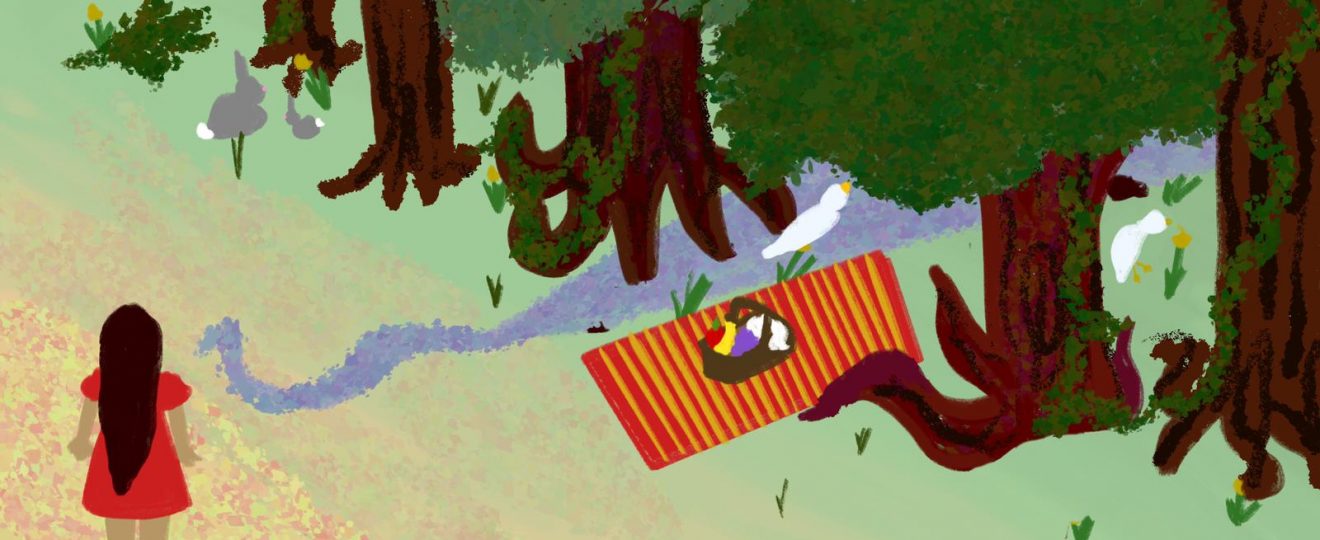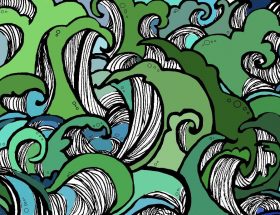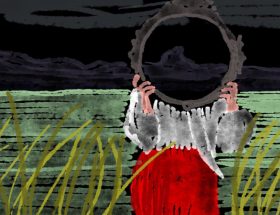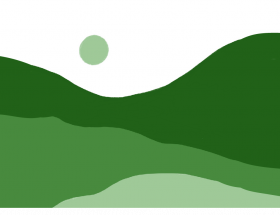We believe we are connected to our sense of self by the name we are given at birth. In actuality, we choose to identify with our names: either by accepting our birth name or by choosing one that we prefer as adults. But all the same, I like to think names and their meanings set an individual up with a type of destiny, perhaps even an expectation of what they can achieve, or a quality they must possess. Floral names, for example, such as Rose, or Petunia, will instil opposing emotions within you. When I think of ‘Rose’ I think of Sleeping Beauty (Briar Rose), but the name ‘Petunia’ brings back flashes of Harry Potter’s horrendous aunt. Then there’s the whole debacle of Daisy versus Myrtle from The Great Gatsby, but if I decided to write about that, this article would be a repeat of my Year 13 Literature coursework essay. Thus, I shall refrain. (However, do let me know if you would like me to forward that essay on if you are interested in reading my teen ramblings).
You may be thinking, “Keyona, where are you going with this?” as I try to succinctly explore the rather convoluted chatter in my brain. My dear reader, I (rather selfishly) would like to discuss my own name. Keyona. Do not be swayed by how it may appear on the page, as it is pronounced Key-ah-na. In Farsi/Persian, it means ‘nature’. The meaning of my name has changed for me over the years. It seemed altogether ironic for most of my life. You see, I grew up in a desert. Humid and hot beyond imagination, nature in Doha was various shades of beige in peaks and troughs, leaving residue behind at every construction site in the city (and believe you me there were a lot of those). Nature was dates falling off date trees. Nature was the deceptively gnarled branches of stiff plants that appeared dead, and cacti for miles and miles. Nature meant staying indoors over summer, hiding from the harsh glare of the 50 degree sun and watching TV instead of playing in parks with friends. And staying indoors meant never learning to ride a bike. Bear in mind, I did spend the entirety of my childhood in the mainly sandy Doha. This tends to make children rather lazy. Or maybe it was just me. But I digress. Whenever we took trips to Europe, places like Germany, Switzerland, and Spain, I was shocked – and incredibly overjoyed – at the sheer amount of greenery, especially surprising in large cities. It was foreign to me, this incredible burst of colour that was so removed from my definition of nature. I had never seen skies so blue.
Over the years, Doha began to introduce more and more man-made structures of nature, from beautiful green parks in the middle of the city, to green thumb initiatives within schools. Looking back, the difference is astronomical. In 2021, children can go to several different parks, including a national park. In 2007, I had the Corniche – the name of the seaside pathway you could walk around – which was littered with sparse greenness, greenness actually better described as dried sage. That, coupled with the unbearable heat, was enough to make anyone scoff, “Ugh. Nature”, laced with sarcasm as they watched sand granules attacking the city on particularly windy days.
To cut to the chase, that all changed. And by ‘that’ I mean my perspective of nature. I remember going on a walk a few months ago with two of my academic children. We stopped to take pictures of the rocks and sea, and one of them turned to me and asked, “How do you take pictures of the same spots over and over again? Surely you have enough after nearly three years.” At the time, I was initially confused, but he prompted me to think more about this point of view. A European, who, having lived in Europe his entire life, was so used to this type of nature, that he took it for granted. It may seem hyperbolic, but each and every time I walk around St Andrews, I am left speechless at its immeasurable beauty (when it’s not pouring rain of course – then I am left howling for an entirely different reason). I think a lot of people forget to appreciate the planet for all the natural resources it possesses. Without prattling on about how appreciative I am for too long, I do believe the lockdowns of the past year and a half have reiterated the importance of fresh air and being outdoors. In a time where most people stared at four walls and mindlessly clicked “Next Episode” on Netflix, stuck at home on government orders, open spaces in nature became a pillar of sanity. Our one form of daily outdoor exercise became my saving grace. The sharp cool air that nipped across my face in waves kept me tethered to nature, tethered to a sense of reality, when the rest of life had seemingly lost its meaning to the pandemic. This brings to mind a small anecdote. I had taken up the ‘one second a day’ trend in 2020 and I felt it was imperative to continue taking snapshots of my days. A friend of mine had given up. “What’s the point?” she asked, “There’s nothing left to capture”. And sure, the seconds became much quieter than they had been, but they managed to capture second after second of the glorious surroundings I lived in. So I told my academic son that there are newfound pleasures in each and every moment I capture. Rays of blue may one day be flashes of fuchsia, lilac, and bursts of orange and red. That, though I photograph the same places, new memories are infused into each picture. Even images taken a mere day apart can tell completely different stories. I have always been stunned by the photographs that are taken of one spot over several months. These photographs, when merged together, can show us the various movements of nature. A particular favourite of mine is the full moon over twelve months. Each of the twelve moons appears to be photographed in a different part of the night sky, but the camera never moves: a physical reflection of the earth moving around the sun. It shows that we can learn so much about the planet and the universe, if only we cared to observe them.
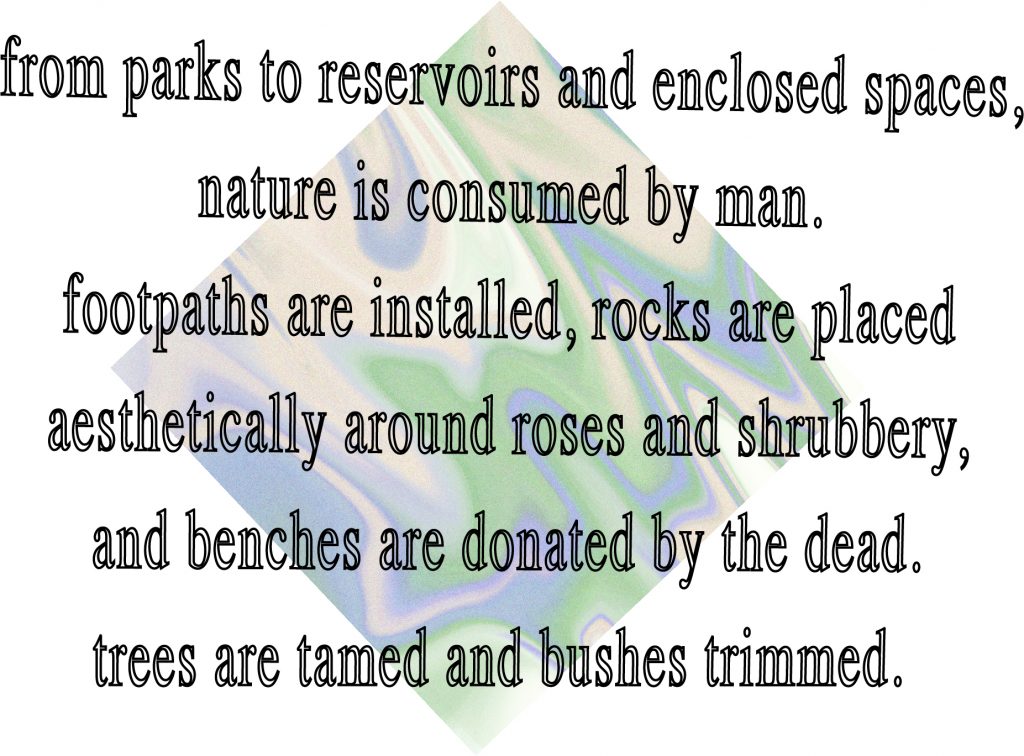
Since moving to St Andrews, my experiences with nature have utterly shifted. The girl who used to complain at having to walk for fifteen minutes now goes on five hour hikes and isn’t afraid to sit in the grass (yes, I know that just sounds silly). With a little perseverance (and a lot of forced walking), I have grown into my name. I have chosen to identify myself with the meaning of my name. I still may not be a garden faerie – frolicking with the ducks in the Kinnesburn– but I am at one with nature. Or at least, the nature I find comfortable.
This brings me to the second part of this article, where I would like to delve into modern concepts of nature. Almost all of you reading this will be aware of the contemporary ‘construction’ of nature, i.e. man-made environments. From parks to reservoirs and enclosed spaces, nature is consumed by man. Footpaths are installed, rocks are placed aesthetically around roses and shrubbery, and benches are donated by the dead. Trees are tamed and bushes trimmed. Now, this is all lovely. A landscape you can admire endlessly. Surroundings in pristine condition, songbirds twittering their assent. And yet, therein lies a falsity, a nagging sense that this picturesque world is manufactured, a world that is almost too perfect.
Now for a change of scenery. Envision the dark, wet, and unruly. Insects you have never encountered before crawl across the uneven ground, and predatory birds make the shadows their home as they stalk the vulnerable. Hisses can be heard passing by your feet. Perhaps something slimy will slink its tail around your leg. One can never be too sure in the wild. A solitary call from a wolf to its partner sends chills up your spine and the wind whispers in your ears. In the midst of this mesmerizingly terrifying madness is the reality of a world untainted by human-induced ecological disturbances. It is something much more hardy than the urban dweller is accustomed to.It has also become increasingly obvious that the average Western human is rather ill-equipped when it comes to dealing with this version of nature (the wild kind). Gone are the days of lighting a fire from sparks using rocks in the forest. There is a nagging sense that if we are unable to utilise millions of years worth of evolution for survival, have we lost what it means to be human? What exactly is the reason for our lack of survival skills? Sure, we could blame modernisation for affording us the various privileges we have: food we can purchase from supermarkets, vehicles for quick forms of transportation, sturdy buildings with roofs over our heads, and so much more. Alas, dear reader, the reason is simple. We, as city-living humans, have become lazy. We have adapted and become entirely reliant on comfort. Accustomed to modernity with a life of luxury, there is no chance you would catch me without my skincare routine and a lack of a clean water source. The closest thing I have experienced to a world without technology was the Duke of Edinburgh’s International Award. And it nearly killed me (but please remember this was back in our sandy-Keyona stage of life). So why would we go back? It would make no sense. I guess the point I am trying to make here is that while there is no way we would go back to living without our modern comforts (unless we suffered an apocalypse), there is perhaps room to learn to survive if we ever needed to. Or at least, to be able to make a fire when none of our lighters work.


